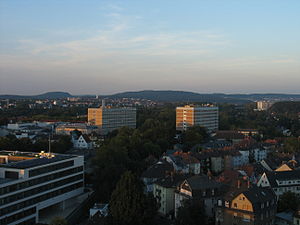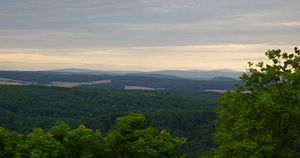Hangelstein
| Hangelstein | ||
|---|---|---|
|
The Hangelstein (center) from the Giessen skyscraper; |
||
| height | 305 m | |
| location | District of Giessen , Hesse | |
| Mountains | Front Vogelsberg | |
| Coordinates | 50 ° 37 '52 " N , 8 ° 43' 42" E | |
|
|
||
| rock | basalt | |
|
The Hangelstein (center) and Lollarkopf (right of it) from the north-northeast; |
||
The Hangelstein is a 200 to 305 m high mountain located about 6 km northeast of downtown Giessen . It belongs to the "actual" Vogelsberg to the north-west of the Vorderen Vogelsberg and, like the Vogelsberg itself, is of volcanic origin and therefore consists largely of basalt . The basalt deposit , in which there are small olivine sprinkles, is of sub-volcanic origin and is classified by Schottler as one of the feldspar- free limburgitic basalts. The rock pulpit is located in the western part of the Hangelstein. This rock formation consists of horizontally lying columns of separated basalt and served as a quarry in the Middle Ages.
The heavily forested mountain is mainly covered with deciduous forest. The mountain serves, among other things, as a local recreation area for the nearby Wieseck district of Giessen . The area is particularly popular with joggers, hikers, cyclists and walkers on nice days.
traffic
The north flank of the mountain is bounded by the A 485 , the western slope by the A 480 , which becomes the B 3 to the north . Their paths separated in the northwest of the 281 m high Lollarkopf behind which the city Lollar is.
Rivers
The motorways 485 and 480 border on the northern and western edges. In the south the area gradually merges into the Wieseckaue , to the north-northeast of the mountain lies the Hainbach confluence with the Lumda . These rivers, together with the Lahn passing to the west, limit Hangelstein and Lollarkopf orographically in all directions except for the east, where Grossen-Buseck is located.
Hangelstein nature reserve
The area has long been known to be of botanical interest. So it visited z. B. also the famous Frankfurt researcher Johann Christian Senckenberg . For this reason there is a 107 ha (1.07 km²) nature reserve of the same name on the hilltop region, which is of national importance from a vegetation and floristic point of view. The vegetation is particularly characterized by rare, heat-loving plants. Due to the Neolithic ( Michelsberg culture ) and Bronze Age ( urn field culture ) finds as well as the remains of a Celtic ring wall , the Hangelstein has not only ecological but also cultural and historical importance. The area was placed under protection as early as 1939 and expanded to its present size in 1976.
gallery
Individual evidence
- ↑ W. Schottler: Explanation to the Geological Map of the Grand Duchy of Hesse 1:25 000, sheet molding. Darmstadt 1913.
- ↑ R. Weyl (ed.): Geological guide Gießen and surroundings. 2nd Edition. Mittelhessische Druck- und Verlagsgesellschaft, Giessen 1980.
- ↑ E. Türk (Ed.): The district of Gießen. Between Lahn and Vogelsberg. Konrad Theiss Verlag, Stuttgart / Aalen 1976, p. 29.
literature
- E. Schubert: The Hangelstein. Leaflet for the ramparts near Gießen-Wieseck, district of Gießen. (= Archaeological Monuments in Hessen, Issue 126). State Office for Monument Preservation Hesse, Wiesbaden 1995, ISBN 3-89822-126-1 .





